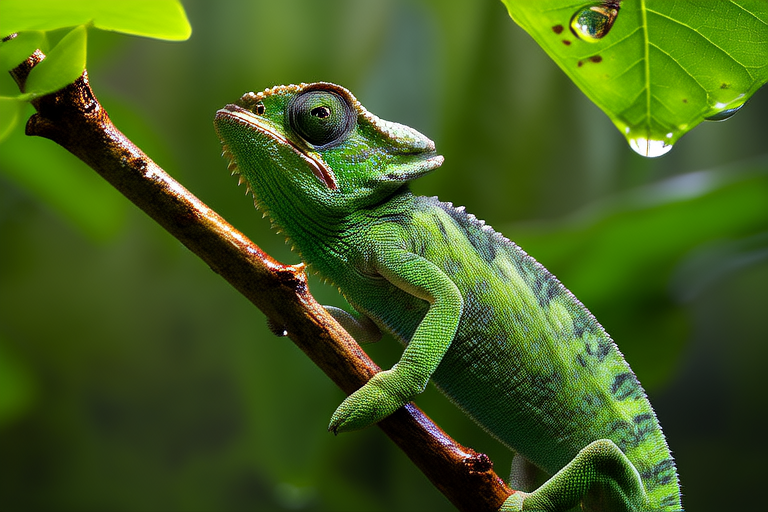5 Common Myths About Chameleons Debunked Once and For All
Chameleons have long been surrounded by myths and misconceptions. These fascinating creatures, with their unique physical characteristics and behaviors, often lead to misunderstandings about their true nature. In this article, we will debunk five common myths about chameleons and provide you with factual information supported by their biology, behavior, and habitat. Additionally, we’ll offer some tips on proper care for these captivating reptiles.
Myth 1: Chameleons Change Color Only to Match Their Surroundings
The idea that chameleons change color solely to blend into their environment is one of the most enduring myths about these creatures. While it’s true that chameleons can alter their appearance, the primary reasons for this behavior go far beyond camouflage.
Chameleons change color as a form of communication, temperature regulation, and mood expression. Their ability to shift hues comes from specialized cells called chromatophores, which contain pigments. By adjusting the arrangement of these cells, chameleons can produce a wide range of colors. For example, a male chameleon may turn bright colors during courtship displays or darker shades when threatened.
So, while chameleons can indeed change color to match their surroundings, this is not their sole purpose. Understanding this helps us appreciate the complexity of their behavior and the importance of providing an enriched environment for them in captivity. Ensure your pet has plenty of branches and foliage to climb on, mimicking its natural habitat and allowing it to express its full range of behaviors.
Myth 2: Chameleons Can Change to Any Color They Want
Another popular misconception is that chameleons can change to any color at will. This belief stems from the impressive array of colors chameleons display, but the truth is more nuanced. The colors chameleons can produce are limited by their genetics and the structure of their chromatophore cells.
Each species of chameleon has a specific palette of colors it can exhibit. For instance, panther chameleons are known for their vibrant reds, oranges, and yellows, while veiled chameleons tend toward greens and browns. These colors serve various functions, such as signaling health, mood, and reproductive readiness.
When caring for a chameleon, it’s essential to understand its natural coloration and behavior. Providing a balanced diet rich in nutrients, especially those that promote healthy skin and pigment production, can help maintain your pet’s vibrant appearance. Remember, the variety of colors seen in captivity is influenced by both genetic predisposition and environmental factors.
Myth 3: Chameleons Change Color Quickly to Avoid Predators
While it might seem logical that chameleons would change color rapidly to evade predators, research suggests that this isn’t typically how they respond to threats. Instead, color changes in chameleons are usually slower processes that occur over several seconds or minutes.
When threatened, a chameleon might darken its color to appear larger and more intimidating to potential predators. Alternatively, it could lighten up to reflect sunlight and cool down its body temperature. In either case, the speed and purpose of the color change depend on the situation and the chameleon’s immediate needs.
To ensure your chameleon feels secure in its enclosure, provide ample hiding spots and vertical climbing structures. A well-designed habitat that mimics their natural environment can reduce stress and encourage natural behaviors. This setup will help your pet feel more comfortable and less likely to need rapid color changes due to perceived danger.
Myth 4: Chameleons Use Their Tongues to Breathe
This myth is perhaps one of the most amusing yet incorrect assumptions about chameleons. The idea that chameleons use their tongues for breathing likely stems from the incredible speed and accuracy with which they catch prey.
In reality, chameleons use their tongues to capture insects, not to breathe. Their tongues are incredibly specialized, capable of extending up to twice their body length in just milliseconds. This adaptation allows them to catch flying insects mid-air, making them efficient hunters.
Proper care for a chameleon includes maintaining optimal humidity levels within the enclosure. While chameleons don’t breathe through their tongues, they do require moist air to aid in shedding and overall health. Mist the enclosure regularly and provide a shallow water dish for drinking and soaking.
Myth 5: Chameleons Thrive in Various Habitats Including Deserts
Contrary to popular belief, chameleons are not desert dwellers. Most species prefer tropical and subtropical forests, where they find the ideal combination of humidity, temperature, and vegetation. Desert environments lack the dense foliage and consistent moisture chameleons need to thrive.
Understanding the specific needs of your chameleon’s species is crucial for providing the right environment. For example, Jackson’s chameleons come from high-altitude rainforests in Kenya and Tanzania, requiring cooler temperatures and higher humidity than many other species.
Creating a suitable habitat involves replicating the conditions found in the chameleon’s natural environment. Use a screen cage to allow for proper ventilation and install UVB lighting to simulate sunlight. Regular misting and appropriate heating devices will help maintain the correct humidity and temperature levels.
By debunking these myths and understanding the true nature of chameleons, we can better appreciate these remarkable animals and provide them with the care they deserve. Whether you’re a seasoned herpetologist or a curious novice, learning about chameleons’ biology, behavior, and habitat will enrich your experience with these captivating creatures.
